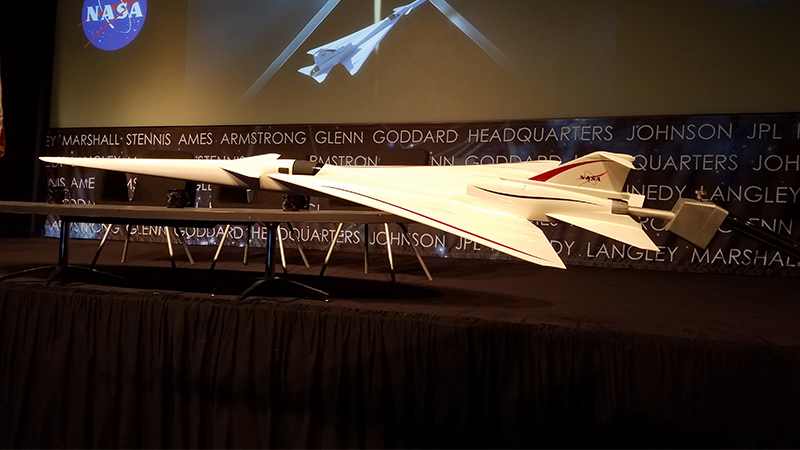Stay Up to Date
Submit your email address to receive the latest industry and Aerospace America news.
The contractor will build an experimental plane aimed at reducing the noise of a sonic boom to a sonic thump
This story was updated Tuesday after the announcement.
NASA on Tuesday announced that it has selected Lockheed Martin Skunk Works to receive a $247.5 million contract to build a piloted X-plane by December 2021 that will test technologies for reducing the noise of a sonic boom enough to permit supersonic flights across the U.S.
Lockheed Martin will begin manufacturing the experimental plane “next summer,” said Peter Iosifidis, Low-Boom Flight Demonstrator program manager of Lockheed Martin Skunk Works in Palmdale, California. He and other officials spoke during a press conference at NASA headquarters in Washington, D.C.
The concept for the X-plane is not significantly different from the design that Lockheed Martin created for NASA in 2016 as part of a contract with the agency called the Quiet Supersonic Technology, or QueSST, aircraft. That initial concept was created for functionality to meet the low-boom technology requirements, he said, but the company will make that design more detailed, including tubing and brackets to fit together subsystems of the aircraft with the aim of making the first safety test flight in 2021.
NASA has said it wants to reduce the noise of a sonic boom to a “sonic thump” when the X-plane cruises supersonically at 55,000 feet, equivalent to 75 perceived Level decibel, which is “about as loud as a car door closing.” An X-plane designation for the low-boom supersonic plane will be issued by the U.S. Department of Defense “by the end of the summer,” Peter Coen, project manager for NASA’s Commercial Supersonics Technology Project, said during the press conference.
“The long nose sets up a relatively weak initial shock,” Coen told me after the press conference regarding how the X-plane’s frame is designed to produce “a gradual rise in pressure” and space out air shockwaves to prevent them from combining to create a powerful sonic boom. “The canopy is very faired over, it doesn’t stick out like a typical aircraft canopy.”
This noise reduction design would be less effective at speeds faster than Mach 2, Coen told me, explaining that the “sweet spot” high-altitude cruise speed for the low-boom design would be up to Mach 1.8. The average commercial flight travels at a high-altitude cruise speed of Mach .85, he said.
A request for proposals published last August by NASA’s Armstrong Flight Research Center in California sought bids to build an experimental plane capable of flying at Mach 1.4 for “low-boom flight demonstration.” There were four inquiries to the proposal process but Lockheed Martin Aeronautics was the only formal bidder, a NASA contracting officer told me, adding those inquiries are private.
The construction and eventual test flights of this demonstrator are intended as part of the coordination among NASA, the FAA and the United Nations’ International Civil Aviation Organization to create regulations that would make it possible for commercial flights to fly faster than Mach 1 over land. Commercial aircraft flying in European and U.S. airspace are forbidden from breaking the sound barrier over land because a sonic boom can roll for 40 kilometers in either direction of a supersonic jet, causing noise pollution for people who live nowhere near a supersonic jet’s flight path.
NASA aims to survey responses from a wide range of communities within an 80-square-kilometer area that will hear noise from supersonic test flights of the X-plane, said Ed Waggoner, program director for NASA’s Integrated Aviation Systems Program, after the press conference. Following the safety test flights of the X-plane at Edwards Air Force base in California, NASA will fly “up to six test campaigns” over cities and small towns that have not yet been chosen between 2023 and 2025, Waggoner said. These flights are being planned to ensure that community response and noise data will be ready in time for meetings of international groups including ICAO, he said.
Companies including Nevada-based Aerion and Boom Technology of Colorado are developing business jets capable of flying faster than Mach 1 with the promise of cutting flight times in half compared with subsonic commercial flights. Without new regulations, those jets will be confined to flying supersonically across oceans. The X-plane is not a prototype for a commercial airline, but the technology will be a foundation for companies to learn from when building supersonic passenger jets, said Jaiwon Shin, NASA’s associate administrator for aeronautics.
“We really want U.S. companies to be the first” to build quiet supersonic aircraft with the resulting NASA low-boom technology, Shin said. He added that NASA also wants to “stay away” from any international tech transfer process that would restrict or delay non-U.S. companies from accessing the tech.
About Tom Risen
As our staff reporter from 2017-2018, Tom covered breaking news and wrote features. He has reported for U.S. News & World Report, Slate and Atlantic Media.
Related Posts
Stay Up to Date
Submit your email address to receive the latest industry and Aerospace America news.




